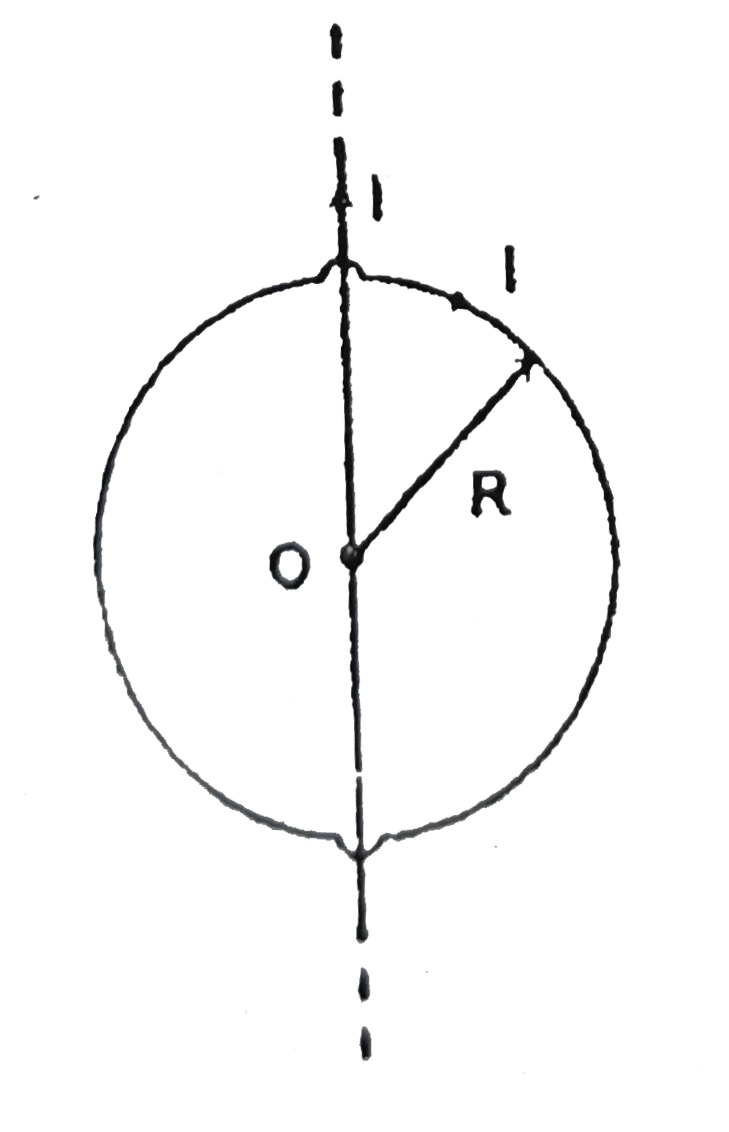A cylinder conductor AB of non uniform area of cross-section carries a current of 5A. The radius of the conductor at one end A is 0.5 cm.The current density at the other end of the conductor is half of the value at A. The radius of the conductor at the end B is nearly
1.4 cm
0.7 cm
0.6cm
None of these
The correct Answer is:B
To solve the problem, we need to find the radius of the conductor at the end B, given that the current density at B is half of that at A. Let's break down the solution step by step.
1. Identify Given Values:
- Current (I) = 5 A
- Radius at end A (r_A) = 0.5 cm
- Current density at end B (J_B) = 0.5 * J_A
2. Formula for Current Density:
- The current density (J) is defined as:
J=IA
- Where A is the cross-sectional area of the conductor. For a circular cross-section, the area A is given by:
A=πr2
3. Calculate Current Density at End A:
- The area at end A (A_A) can be calculated as:
AA=π(rA)2=π(0.5cm)2=π(0.25cm2)
- Thus, the current density at end A (J_A) is:
JA=IAA=5Aπ(0.25cm2)=20πA/cm2
4. Current Density at End B:
- Since J_B = 0.5 * J_A, we have:
JB=0.5×20π=10πA/cm2
5. Area at End B:
- The area at end B (A_B) can be expressed in terms of the radius at B (r_B):
AB=π(rB)2
- Using the definition of current density at end B:
JB=IAB⟹10π=5π(rB)2
6. Solving for r_B:
- Rearranging the equation gives:
10⋅(rB)2=5⟹(rB)2=510=0.5
- Taking the square root:
rB=√0.5=1√2≈0.707cm
7. Final Answer:
- The radius at end B (r_B) is approximately 0.7 cm.
Conclusion:
The radius of the conductor at the end B is nearly 0.7 cm.
- Current (I) = 5 A
- Radius at end A (r_A) = 0.5 cm
- Current density at end B (J_B) = 0.5 * J_A
- The current density (J) is defined as:
J=IA
- Where A is the cross-sectional area of the conductor. For a circular cross-section, the area A is given by:
A=πr2
- The area at end A (A_A) can be calculated as:
AA=π(rA)2=π(0.5cm)2=π(0.25cm2)
- Thus, the current density at end A (J_A) is:
JA=IAA=5Aπ(0.25cm2)=20πA/cm2
- Since J_B = 0.5 * J_A, we have:
JB=0.5×20π=10πA/cm2
- The area at end B (A_B) can be expressed in terms of the radius at B (r_B):
AB=π(rB)2
- Using the definition of current density at end B:
JB=IAB⟹10π=5π(rB)2
- Rearranging the equation gives:
10⋅(rB)2=5⟹(rB)2=510=0.5
- Taking the square root:
rB=√0.5=1√2≈0.707cm
- The radius at end B (r_B) is approximately 0.7 cm.
The radius of the conductor at the end B is nearly 0.7 cm.
Topper's Solved these Questions
- SOLVED PAPER 2017BOOK - DC PANDEY ENGLISHCHAPTER - SOLVED PAPER 2017EXERCISE - Solved papers 2017(JIPMER)
32 Videos
- SOLVED PAPER 2017BOOK - DC PANDEY ENGLISHCHAPTER - SOLVED PAPER 2017EXERCISE - Solved papers 2017(JIPMER)
32 Videos
- SEMICONDUCTORSBOOK - DC PANDEY ENGLISHCHAPTER - SEMICONDUCTORSEXERCISE - Subjective
12 Videos
- SOLVED PAPERS 2018BOOK - DC PANDEY ENGLISHCHAPTER - SOLVED PAPERS 2018EXERCISE - JIPMER
22 Videos
Similar Questions
A stready current i is flowing through a conductor of uniform cross-section. Any segment of the conductor has
View SolutionA copper conductor of area of cross- section 40 mm2 on a side carries a constant current of 32×10−6A. Then the current density is (in amp/m2)
View SolutionA conductor-carries a current of 50μA If the area of cross-section of the conductor is 50mm2, then value of the current density in Am−2
View SolutionThe current density is defined as the current flowing per unit area of cross section of the conductor. Its direction is
View SolutionState the direction of the above currents in a conductor, stating which end of the conductor is at high potential.
View SolutionA straight conductor of uniform cross section carries a time varying current, which varies at the rate dI//dt = I. If s is the specific charge that is carried by each charge carries of the conductor and l is the length of the condcutor, then the totalt force experienced by all the charge carries per unit length of the conductor due to their drift velocities only is
View SolutionA current of 1.5A flows through a conductor for 2.0s. What amount of charge passes through the conductor ?
View SolutionA conductor of length l has a non-uniform cross-section. The radius of cross-section varies linearly from a to b. The resistivity of the material is ρ. Find the resistance of the conductc across its ends.

View SolutionA cylinderical conductor of radius R is carrying constant current. The plot of the magnitude of the magnetic field, B with the distance, d from the centre of the conductor , is correctly represented by the figure:
View SolutionA circular conducting loop of radius R carries a current I. Another straight infinite conductor carrying current I passes through the diameter of this loop as shown in the figure. The magnitude of force exerted by the straight conductor on the loop is

View Solution
